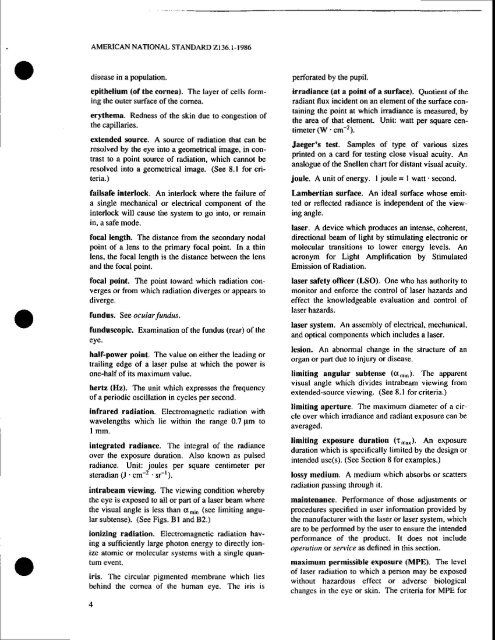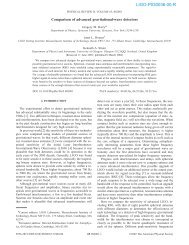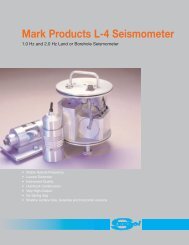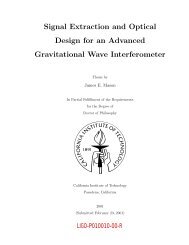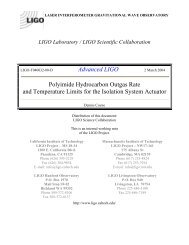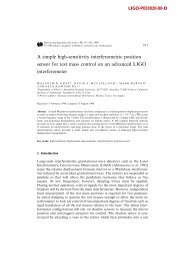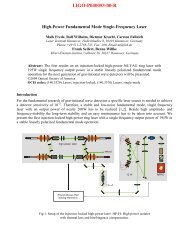for the sqfe use of lqsers - LIGO
for the sqfe use of lqsers - LIGO
for the sqfe use of lqsers - LIGO
You also want an ePaper? Increase the reach of your titles
YUMPU automatically turns print PDFs into web optimized ePapers that Google loves.
AMERICAN NATIONAL STANDARD ZI36.I-I986<br />
disease in a population.<br />
€pi<strong>the</strong>lium (<strong>of</strong> ahe cornea). The layer <strong>of</strong> cells fbrming<br />
<strong>the</strong> outer surface <strong>of</strong> <strong>the</strong> comea.<br />
ery<strong>the</strong>ma. Redness <strong>of</strong> <strong>the</strong> skin due to congestion <strong>of</strong><br />
<strong>the</strong> capillaries.<br />
extended source. A source <strong>of</strong> radiation that can be<br />
resolved by <strong>the</strong> eye into a geometrical image, in contrast<br />
10 a point source <strong>of</strong> radiation, which cannot be<br />
resolved into a geome*ical image. (See 8.1 <strong>for</strong> criteria.)<br />
failsafe interlock. An interlock where <strong>the</strong> failure <strong>of</strong><br />
a single mechanical or electrical component <strong>of</strong> <strong>the</strong><br />
interlock will ca<strong>use</strong> <strong>the</strong> system to go into, or remain<br />
in, a safe mode.<br />
focal length. The distance from <strong>the</strong> secondary nodal<br />
point <strong>of</strong> a lens to <strong>the</strong> primary focal point. In a thin<br />
lens, <strong>the</strong> focal length is <strong>the</strong> distance between <strong>the</strong> lens<br />
and <strong>the</strong> focal point.<br />
focal point. The point toward which radiation converges<br />
or from which radiation diverges or appears to<br />
diverge.<br />
fundus. See oculdr fundus.<br />
funduscopic. Examination <strong>of</strong><strong>the</strong> fundus (rear) <strong>of</strong><strong>the</strong><br />
natf-power poirrt. The value on ei<strong>the</strong>r <strong>the</strong> leading or<br />
trailing edge <strong>of</strong> a laser pulse at which <strong>the</strong> power is<br />
one-half <strong>of</strong> its maximum value.<br />
hertz (Hz). The unit which expresses <strong>the</strong> frequency<br />
<strong>of</strong> a periodic oscillation in cycles per second.<br />
infrar€d radiation. Electromagnetic radiation with<br />
wavelengths which lie within <strong>the</strong> range O.?;rm to<br />
I mm.<br />
integrated radiance. The integral <strong>of</strong> <strong>the</strong> radiance<br />
over <strong>the</strong> exposure duration. Also known as pulsed<br />
radiance. Unit: joules per square centimeter per<br />
steradian (J 'cm-2 sil).<br />
intrabeam viewing. The viewing condition whereby<br />
<strong>the</strong> eye is exposed to all or pan <strong>of</strong> a laser beam where<br />
<strong>the</strong> visual angle is less than clmin (see limiting angular<br />
subtense). (See Figs. Bl and 82.)<br />
ionizing radiation. Electromagnetic radiation having<br />
a sufficiently large photon energy to directly ionize<br />
atomic or molecular systems with a single quantum<br />
event,<br />
iris. The circular pigrnented membrane which lies<br />
behind <strong>the</strong> comea <strong>of</strong> th€ human eve. The iris is<br />
per<strong>for</strong>ated by <strong>the</strong> pupil.<br />
irradiance (al a poinl <strong>of</strong> a surface). Quotient <strong>of</strong> <strong>the</strong><br />
radiant flux incident on an element <strong>of</strong> <strong>the</strong> surface containing<br />
<strong>the</strong> point at which inadiance is measured, by<br />
<strong>the</strong> area <strong>of</strong> that element. Unit watt per square centimeter<br />
(W ' cm-2).<br />
Jaeger's tesa. Samples <strong>of</strong> type <strong>of</strong> various sizes<br />
printed on a card <strong>for</strong> testing close visual acuity. An<br />
analogue <strong>of</strong> <strong>the</strong> Snellen chan <strong>for</strong> distant visual acuity.<br />
joule. A unit <strong>of</strong> energy. I joule = I watt ' second.<br />
Lambertian surface. An ideal surface whose emitted<br />
or rcflected radiance is independent <strong>of</strong> <strong>the</strong> viewing<br />
angle.<br />
laser. A device which produces an intense, coherent,<br />
directional beam <strong>of</strong> light by stimulating electronic or<br />
molecular transitions to lower energy levels. An<br />
acmnym <strong>for</strong> Light Amplification by Stimulated<br />
Emission <strong>of</strong> Radiation.<br />
laser safety <strong>of</strong>ficer (LSO). One who has authority to<br />
monitor and en<strong>for</strong>ce <strong>the</strong> conhol <strong>of</strong> laser hazards and<br />
effect <strong>the</strong> knowledgeable evaluation and control <strong>of</strong><br />
laser hazards.<br />
laser system. An assembly <strong>of</strong>electrical, mechanical,<br />
and optical components which includes a laser.<br />
lesion. An abnormal change in <strong>the</strong> structure <strong>of</strong> an<br />
organ or purt due to injury or disease.<br />
limiting angular sublense (dmin). The apparent<br />
visual angle which divides intrabeam viewing from<br />
extended-source viewing, (See 8.1 <strong>for</strong> criteria,)<br />
limiting aperture. The maximum diameter <strong>of</strong> a circle<br />
over which inadiance and radiant exoosure can be<br />
averaged,<br />
limiting exposure duration (tma,(). An exposure<br />
duration which is specifically limited by <strong>the</strong> design or<br />
intended <strong>use</strong>(s). (See Section 8 <strong>for</strong> examples.)<br />
lossy medium. A medium which absorbs or scatters<br />
radiation passing thruugh i1.<br />
maint€nsnce. Per<strong>for</strong>mance <strong>of</strong> those adjustments or<br />
procedures specified in <strong>use</strong>r in<strong>for</strong>mation provided by<br />
<strong>the</strong> manufacturer with <strong>the</strong> laser or laser system, which<br />
are to be per<strong>for</strong>med by <strong>the</strong> <strong>use</strong>r to ensure <strong>the</strong> intended<br />
per<strong>for</strong>mance <strong>of</strong> <strong>the</strong> product, It does not include<br />
operation ot seruice as defined in this section.<br />
maximum permissible exposure (MPE). The level<br />
<strong>of</strong> laser radiation to which a person may be exposed<br />
without hazardous effecl or adverse biological<br />
changes in <strong>the</strong> eye or skin. The criteria <strong>for</strong> MPE <strong>for</strong>


